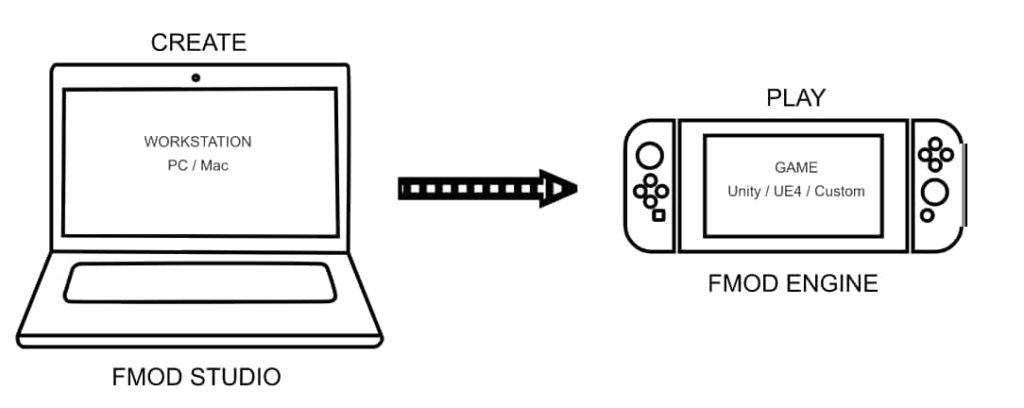Whether you’re a new indie developer or a seasoned pro, you know good audio is key to a great game. But what’s the best format for your audio files? WAV, MP3, or OGG?
As a general rule, if you are limited on audio file size, the best audio format to use in sound design for video game development is OGG VORBIS.
However, the truly best solution is to use a “middleware” programs such as FMOD or WWISE which can help you process high-quality audio files like .WAV files in major game engines such as Unity or Unreal Engine.
Music and sound effects are a fundamental part of video game development and it is important to ensure the quality of the audio and music in your game sound good.
No doubt you will spend hours programming and developing your game, but as many indie video game developers do not have a dedicated sound designer to handle their audio assets, it is important to know what audio quality you should aim for.
In this article I will cover:
- What do we mean by audio quality?
- What is FMOD & WWISE?
- Why does audio format matter in video game design?
- Why MP3 audio is not good for video game sound design?
- What are .OGG files and why should you use them in video game audio design?
- Is there a free way to convert .WAV or other formats into .OGG format?

What Do We Mean By “Audio Quality”?
Audio files have technical specifications attached to them and the two most important from an audio quality point of view are:
- Sample Rate
- Bit Rate
What Does Audio Sample Rate Mean?
The sample rate is the number of times the audio is sampled per second.
For CD quality, the sample quality is 44.1kHz.
What Does Audio Bit Rate Mean?
This is the number of bits within a unit of playback.
For CD quality, the bit rate is 16bit.
I appreciate that this probably makes no sense if you are not familiar with audio, so here is a simple way to think of it I recall from my student days at sound engineering school.
- Think of sample rate as little snapshots of sound, like frames per second in a movie.
- Think of bit rate as resolution.
Regarding which audio quality and sampling rates sound best, there are endless threads online on this topic.
Audiophiles (audio experts and enthusiasts) argue that high-resolution audio with a sampling frequency of 96kHz/24bit is the only way to go while others argue that lossless audio such as MP3 with a sampling frequency of 44.1kHz / 320 kbs is fine as most people don’t have access to high-quality headphones and speakers to hear the difference.
When it comes to sound design and using music in video games, we need to have as high an audio quality as possible, however, depending on your setup you may need to ensure your audio files or audio assets do not have a large file size.
It would be great if we could all use high-resolution audio as there would never be an audio compromise, but high-quality audio files are large and are just too big for some indie game developers to work with.
Therefore, for most indie game developers, there is a constant battle between wanting the best quality but at the smallest file size.
When selecting an audio file type for video game development, and assuming you are limited in space, choose the audio file format OGG VORBIS. This is similar in size to MP3, but unlike MP3 can be looped seamlessly.
However, the truly best solution is to use a “middleware” programs such as FMOD or WWISE which can help you process high-quality audio files such as .WAV files in most game engines.
What is FMOD & WWISE?
FMOD Studio is a software that allows you to easily add sound and music to any game. You can easily make your audio “adaptive” which means you can easily loop, trim, edit and adapt it for your gameplay.
It is an incredibly versatile software package that can be easily integrated with Unity, Unreal Engine 4 (UE4) and other engines through APIs.
The great news about FFMOD is if you are an indie game developer and have a budget of less than $500k, you can use it for free subject to their terms and conditions.

WWISE is an alternative interactive audio solution for games and game developers. It too has a free starter package for productions with a budget of less than $150k.
So before you take the manual route and start trimming and looping your game music and sounds in free software such as Audacity, be sure to check out these middleware software options as you could efficiently manage your audio assets with direct integration with the major game development engines.
At a first glance, it may seem daunting and exhausting to learn a new software package, but they are surprisingly easy to learn with a vast amount of tutorials and information online.
Here are some excellent resources to get started and learn FMOD or WWISE to manage your audio assets.
1. FMOD YouTube Channel
2. WWISE Free Courses
Why Does File Format Matter In Video Game Design?
Creating smooth audio loops in video game audio design is essential and having the correct file format will help you create seamless loops.
When I am talking about file formats, I am referring to the various audio file formats out there – for example .WAV, .MP3., and FLAC to name a few.
When using uncompressed file formats such as .WAV files , you are working with high-quality audio that you can seamlessly loop, however, as mentioned previously, you will notice that as you work with these files as a video game developer, the file size is massive!
When you have hundreds of sound assets, you need to really consider file size and space. Very quickly, your video game sounds and music will take up more data space than your actual game.
Why MP3 Audio Is Not Good For Video Game Sound Design?
As mentioned, working with uncompressed file formats such as .WAV will give you excellent quality but are just too large to use for some indie game developers.
The next option to maintain high-quality audio but also achieve a small file size is to use a compressed audio file format, such as .MP3 or OGG.
MP3 is hugely popular and a format the general population is very comfortable with. However, you shouldn’t choose MP3 when working with video game music and sounds in video game audio because they do not loop well and here is why.
MP3 encodes its data in blocks of 1224 bits. If the last block of music or sound effect is not exactly 1224bits, the MP3 encoder will insert some silence or junk data to make up an even block of 1224 bits.
This means that when looping MP3s (music loops are essential in game design) more than likely there will be a tiny bit of silence at the end of your audio snip. Therefore, this will not loop seamlessly. You will hear a little click or hitch in the loop.
What Are .OGG Files And Why Should You Use Them In Video Game Audio Design?
So .WAV or uncompressed files are too big for efficient video game sound design and .MP3 files are a poor option for looping, so is there a middle ground?
The best audio file type for video game design is .OGG for the following reasons:
- OGG is about the same file size as .MP3.
- The .OGG audio file type is open source.
- .OGG audio files loop perfectly.
So when you are working with video game music or sound effects and you need an audio file format that is not too big but loops well and works well with all the major game development engines, choose high quality .OGG.
Is There A Free Way To Convert .WAV Or Other Formats Into .OGG Format?
The fastest and free way is to use open-source software such as Audacity.
Audacity is an open-source, free, cross-platform audio software that is excellent for converting music and sound effect formats to .OGG.
Final Thoughts
Though it is possible to create a great game soundtrack without using specialised audio middleware, it is much more difficult and time-consuming.
FMOD Studio and WWISE are two of the best audio management programs available for game development, and they can save you untold hours in sound design work.
If you don’t have access to these programs, or if you need to use a different file format such as .MP3 or .WAV, then be sure to use OGG files instead.
Their smaller size will keep your storage requirements down, and their seamless looping will make your game soundtrack more immersive for your players.
